In the mid-1960’s, television realized that it had to acknowledge that there was something going on out there in reality-land that did not conform to the standard paradigm of the way big people do things in America– because there was money in it (which was exactly the way big people did things anyway) and so they deigned to acknowledge rock’n’roll and decided to occasionally allow a rock’n’roll band onto the Ed Sullivan Show or Hootenanny or Hullabaloo.
But what do you do with them? How do you pose them? What do you put in the background? How much do we have to pay them?
They discovered that if you played the recording while the band faked a performance of the song, you didn’t have to pay very much for the performance. It was technically promotion, not a performance. Union rules didn’t apply. So Dick Clark, who I really believe is the king pimp of all television pimps, week after week, on American Bandstand, featured musicians standing in front of real teens from America lip-synching to their own tunes. Did they think we were fooled? I don’t know. I’m not too sure.
Did they think we were stupid? Without a doubt.
On Ed Sullivan, the bands usually (but not always) really played. You can see cords going from their guitars to their amps– a dead give-away in that era. If there are no cords– it’s lip-synching. Thank you Ed. And it is now time for you to stop introducing Jimmy Morrison and the Doors, Grace Slick and Jefferson Airplane, and Mick Jagger and the Stones, as “something for the youngsters of America”. Weird, wasn’t it? Dean Martin would come out and put all the adults to sleep with songs about pillows that you dream on, and then Mick Jagger would come out for the “youngsters” and tell them he couldn’t get no satisfaction.
The other way you could tell if it was really live was if you heard a mistake. And that’s what gives Grace Slick away in this performance of “White Rabbit” by Jefferson Airplane. It’s real. It’s live. Grace misses the beat on “pill” and has to speed up to catch the beat on “one pill makes you small”. That is her smiling, I’m pretty sure, because she just made a mistake in front of 25 million people. She’s cute, isn’t she? It’s endearing. One minute, she is a poised artist, delivering the amazing goods, the number one hit single in America. Then, just for a second, she’s an embarrassed little girl again who turned the wrong way on the dance floor.
There are a lot of great songs from the sixties, and a lot of great performances. There are only a few performances of great songs. And there are even fewer performances that are so monumental that they seem to leap from their era and genre into a kind of stratosphere of transcendental moments in life. There was Hendrix performing “All Along the Watchtower”, and Dylan doing “Lonesome Death of Hattie Carroll” in London, and the Beatles doing “Hey Jude”. There was Jimmy Morrison doing “Light My Fire”.
And there was Grace Slick performing “White Rabbit”. You have to hear Grace Slick’s voice to believe it. It is incredibly big and powerful and you might believe it could be heard above the electric guitars and drums even without amplification. The only other female singers I can think of with a voice of comparable size are Mama Cass Elliot and Janis Joplin. Grace was sexier than those two and the next top twenty female singers combined.
Grace Slick’s voice probably couldn’t have been small if she’d wanted it too. The first lines of “White Rabbit” are delivered with as much restraint as you could possibly muster for a Sherman tank of a voice. Then she builds, with an insinuating vibrato, like a whip being drawn back. She builds and builds until, by the last lines– “remember what the dormouse said…”– her voice is in full bore, a wall of sound coming at you like a freight train, tidal and relentless, slashing guitars just barely able to provide seething rhythmic foundation to this thing of power and explosive fury.
While Grace Slick was singing like this, the Grammys for best female vocal performance went to Barbara Streisand, Eydie Gorme, Bobbie Gentry, Peggy Lee, and Dionne Warwick. That’s why I haven’t paid any attention to the Grammys for about 40 years.
Grace Slick had beautiful blue eyes and long black hair. She was uncompromising— she quit Jefferson Starship when they went commercial. She drank too much. She got married and divorced, married and divorced. She had one daughter, China, who would be about 30 by now.
“White Rabbit” was written by Grace Slick, inspired by the Lewis Carroll book.
Alice discovers that one pill makes her larger and one pill makes her small. But the pills that mother gives her don’t do anything at all. That about sums up the 1960’s.
White Rabbit was used in a movie called “Go Ask Alice” which purported to show you the true experiences of a bad girl who did some drugs and thereby ended up as a teenage prostitute in Los Angeles and eventually died of an overdose.
If I recall correctly, it wasn’t a terrible movie. But we knew that mother made this film.
Grace Slick – Live
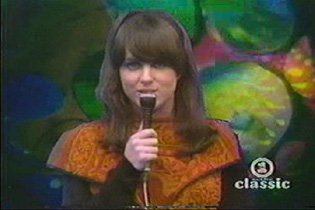
Grace just missed the beat. Looking at yah with those very intense eyes.
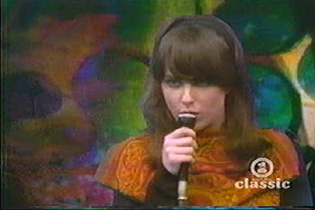
Grace suddenly looks down. You wonder why. She was staring, fetchingly, right at the camera– right at you. Then she looks away, as if she suddenly saw something important

Mystery solved– it’s a second camera. She was coached to look at the camera but someone missed a cue and didn’t switch for about five or six seconds. Dig the psychedelic background? Higher consciousness, baby..
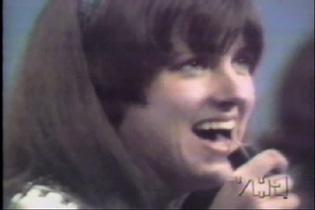
Grace sings to an electrical outlet. I’m not kidding. This is from a performance in which the band lip-synched to “Somebody to Love”– there are no cords on the guitars. So Grace decided to sing to an electrical cord instead of a microphone, and, yes, she’s laughing and making fun of the whole thing.
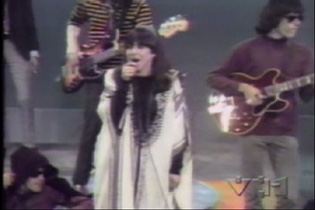
From the same performance. The tambourine player, back row, far left, is holding a cigarette in his left hand. Notice there are no cords on the guitars.
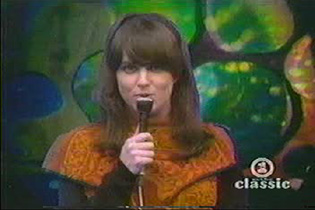
One more from “White Rabbit”. Costuming by Cecil B. De Mille.
